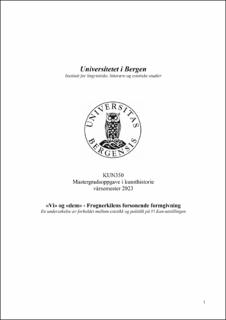«Vi» og «dem» - Frognerkilens forsonende formgivning. En undersøkelse av forholdet mellom estetikk og politikk på Vi Kan-utstillingen
Master thesis

View/
Date
2023-05-15Metadata
Show full item recordCollections
- Master theses [274]
Abstract
Sommeren 1938 ble et langstrakt areal langs Frognerkilen i Oslo fylt med utstillingshaller, restauranter og en egen fornøyelsesavdeling. Anledningen var den store håndverk- og industriutstillingen, der Oslo skulle vise hele Norge at «vi kan». Gjennom en presentasjon av nye forbruksvarer og velferdstilbud, var Vi Kan-utstillingen en demonstrasjon av den moderne industribyen Oslo, og en foregangsfigur for resten av landet. Vi Kan-utstillingen føyer seg i rekken av store industriutstillinger som fant sted internasjonalt fra midten av 1800-tallet. De store verdensutstillingene har blitt beskrevet som speilbilder av verden og den tiden de fant sted. Derfor hadde de også en spesiell definisjonsmakt i hva som ble inkludert og ikke. Kunst, arkitektur og design ble medier for å uttrykke et verdisett, budskap eller en ideologi. De gir derfor en unik innsikt i tidens ånd, samfunnet og det politiske klima. I denne oppgaven analyseres Vi Kan-utstillingens estetikk gjennom en analyse av Arne Korsmos utstillingsarkitektur, monumentalmaleriet til Aage Storstein og Harald Damsleths utstillingsplakat. Formålet med oppgaven er å få en bredere forståelse av forholdet mellom estetikk og politikk på 1930-tallet. During the summer of 1938, a large area along Frongerkilen in Oslo was filled with exhibition halls, restaurants, and a separate amusement section. The occasion was the large handicraft and industrial fair, where Oslo was to show the whole of Norway that «we can.» Through a presentation of new consumer goods and welfare offerings, «We Can» was a demonstration of the modern industrial city of Oslo, as a model for the rest of the country. «We Can» is part of a series of large industrial fairs that took place internationally from the mid-1800s. The world fairs have been described as reflections of the world and the time in which they took place. For that reason, the fairs provide insight into a country’s broader social and political climate at the time. The fairs also played a role in defining what was included in a country’s self-image, and what was not. Art, architecture, and design became ways of expressing a set of values, a worldview, or an ideology. In this thesis, the aesthetics of «We Can» are examined through an analysis of Arne Korsmo’s architectural design of the exhibition, Aage Storsteins painting, and the exhibition’s official poster, designed by Harald Damsleth. This thesis aims to gain a broader understanding of the relationship between aesthetics and politics in the 1930s.